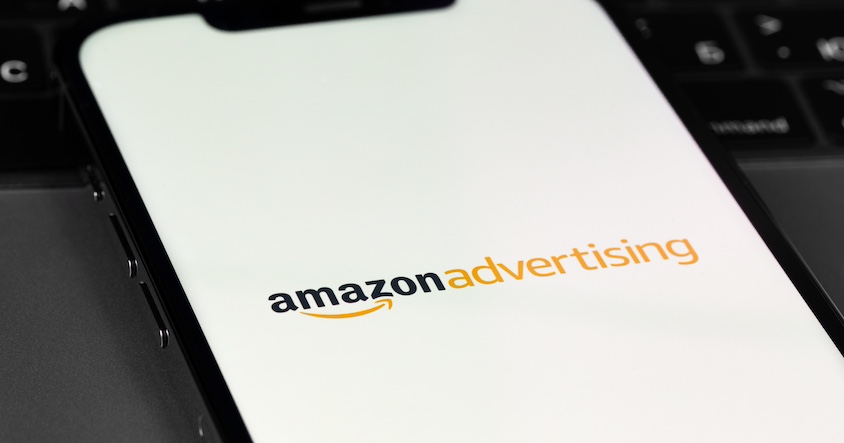Amazon Sponsored Brands: How to make your brand stand out among thousands!

In addition to the classic Sponsored Product Ads, Sponsored Brands ads are also part of Amazon Advertising. Unlike many other advertising formats, this type of ad does not focus on a single product but highlights an entire brand. Therefore, it is not surprising that a Brands campaign primarily serves to increase brand awareness and should thus be classified in the upper part of the marketing funnel.
However, with a well-structured Amazon Sponsored Brands Campaign, deeper funnel stages can also be covered – not least due to their very good click-through rate. We will clarify what goals marketplace sellers can pursue with this ad format further down in this text. First, let’s take a look at what Sponsored Brands Ads look like, where they are displayed, and what requirements sellers must meet to be able to run them.
What are Amazon Sponsored Brands ads?
Many online retailers selling their brand on Amazon face a problem: competition. This may sound trivial at first, as competition exists everywhere. However, online and especially on the Amazon marketplace, the competition is particularly fierce. Only a single search results page is relevant for each search term that customers enter into the search bar of Amazon.de or Amazon.com. Compared to the total number of offers, there are only a few places available, which are increasingly contested the higher up they are on the page. Fighting to get one of your brand’s products there is not easy and may require a lot of time.
To increase awareness and sales, advertising has always been an effective means, whether it’s the barker at the fish market, a print ad in the newspaper, or a digital PPC ad on Amazon. Sellers who want to use Sponsored Brands have the choice of three different ad formats: Product Collection, Store Spotlight, and Video. What they have in common is that they operate based on keyword and product targeting. This means they are not displayed randomly but receive placement only for specific search terms or ASINs or categories. Up to three products can then be displayed (except for video ads).
This example clearly shows why both Sponsored Brands and Sponsored Products ads work so well: they are hardly distinguishable from organic search results but are even displayed before them.
Moreover, Sponsored Brands Ads do not appear everywhere on the Amazon marketplace; they are positioned above, below, or between the organic search results on the search results page. When a customer clicks on the ad, they are directed either to the brand’s Amazon Store, to one of its subpages, or to a product detail page.
Product Collection vs. Store Spotlight vs. Video Ad: Differences at a Glance
This table clearly presents the differences in terms of placement, landing pages, etc., between the various formats:
| Product Collection | Store Spotlight | Video | |
|---|---|---|---|
| Placement on the search results page | Above and below the search results | Above and below the search results | Within the search results |
| Possible landing pages | Amazon Store and its subpages, product detail page, individual landing page (e.g. product list) | Amazon Store and its subpages | Product detail pages |
| Product quantity | 3 | 3 | 1 |
| Logo & Brand name | yes | yes | no |
| Customizable? | Selection of products and their order, heading, image | Selection of stores and their order, heading, image | Only within the video |
| Keyword targeting | yes | yes | yes |
| Product targeting | yes | yes | yes |
Product collection & Store spotlight
On Amazon, Sponsored Brands ads in the formats Product Collection and Store Spotlight differ little from each other. The Product Collection promotes up to three specific products, with selection and order determined by the advertiser. The Spotlight, on the other hand, promotes three stores of a brand, essentially category subpages of the Brand Store. Accordingly, the advertised store serves as the landing page. By clicking on the Product Collection, the customer typically goes directly to the product page of the advertised product. However, store pages or even individual landing pages can also be linked here.
What speaks for having a dedicated Brand Store?
Brand Stores are essentially the showcases of the Amazon marketplace. Here, brands can present themselves undisturbed, free from competition. Because only here is it not possible for competitors to run ads. Additionally, Brand Stores offer customers a shopping experience that they cannot get elsewhere on Amazon: exploring brands, browsing a portfolio, and discovering different categories.
Video ad
The situation is different with video format ads. Although these are labeled as Brand ads, they are more like a Sponsored Products Ad. This is because Amazon Sponsored Brands Video Ads promote a single product using an accompanying video. The respective detail page of the product serves as the landing page.
This makes the video format certainly the most elaborate type among Sponsored Brands Ads, as producing a high-quality video takes time and costs money. But it is worth it: According to Perpetua, video ads often have a click-through rate that is twice as high compared to other Sponsored Brands on Amazon. The RoAS (Return on Ad Spend) is on average 28-43% higher. Thus, the video format is particularly suitable when sellers already have video material for a product or would produce it for another purpose anyway.
Amazon Sponsored Products vs. Sponsored Brands: Is there a difference?
Yes, there is. Not only do Brand ads look different, but advertisers are also more flexible in their design and can customize the ads by adjusting, for example, the headline, the images used, or the landing page. Unlike Sponsored Products Ads, it is also possible to promote multiple products simultaneously, including through video.
There are also some differences in the placement and analysis. Sponsored Products are somewhat the entry point into the Amazon Advertising world, while Sponsored Brands ads are a bit more advanced. Therefore, one will look in vain for an automatic campaign with the latter.
Additionally, Sponsored Brands have a longer attribution window of 14 days. All sales of the same brand that are initiated by an ad count towards the sales – it does not matter whether the sale is processed by the brand owner/advertiser, by Amazon, or by a third-party seller. Therefore, sellers do not need the Buy Box on Amazon to be able to run a Sponsored Brands ad for a brand.

Amazon Sponsored Brands: Best practices for all formats
Some aspects of a good campaign apply to all Sponsored Brands types. The following best practices should definitely be considered by sellers:
Amazon provides all Sponsored Brands specs in a clear manner. Ignoring these would be a waste of time and money, as ads that do not meet the specifications will simply be rejected.
Interesting facts about Sponsored Brands ads
Who can use Sponsored Brands ads?
Not every seller is automatically eligible to run Sponsored Brands ads on Amazon. Various criteria must be met:
How much do Sponsored Brands cost on Amazon?
Marketplace sellers can easily navigate to the corresponding section in Seller Central. Under the “Advertising” tab, there is the campaign management, where a new campaign can be created. The campaign name and campaign type must also be set – in this case, Sponsored Brands.
What are the benefits of Amazon Sponsored Brand campaigns?
Further frequently asked questions
The Sponsored Brands ad is one of three Amazon PPC advertising formats. It allows for the promotion of Brand Stores, store subpages, as well as individual products. Up to three landing pages are possible per ad. Additionally, there are brand ads in video format.
In addition to the classic forms linking to the Brand Store or a product page, advertisers can also use a video in the ad. Then, only one product is promoted, with its detail page serving as the landing page.
Sponsored Brands ads have various placements: They are displayed before or after the organic search results on the search results page. Video Ads are played within the search results.
Normally, any Amazon seller who owns a registered brand or has sales rights for it can run such advertisements.
A flat daily budget cannot be specified here, as Amazon charges for Sponsored Brands ads based on the Pay per Click (PPC) principle. The actual cost per click (CPC) depends particularly on how competitive a keyword is. The ad placement is always won by the one who is willing to pay the most. Thus, there can be keywords with many bidders that drive the price up, and keywords with few bidders, which is why the price does not increase as much.
Conclusion: Sponsored Brands belong in every advertising strategy
Amazon Sponsored Brands Ads may be among the first advertising formats that marketplace sellers try – but that does not mean they should be discarded as the advertiser’s expertise increases. On the contrary! They not only increase brand visibility on Amazon but can also push individual products. Additionally, they often have a better RoAS than other PPC ads.
However, there are several things to consider: The images and videos used should be of high quality and the products should maintain the Buy Box so that the daily budget does not ultimately benefit the competition. Only then are they a valuable component of a comprehensive strategy.
Image credits in the order of the images: © Kevin Carden – stock.adobe.com / Fig. 1 @ amazon.de / Fig. 2 @ perpetua.com










